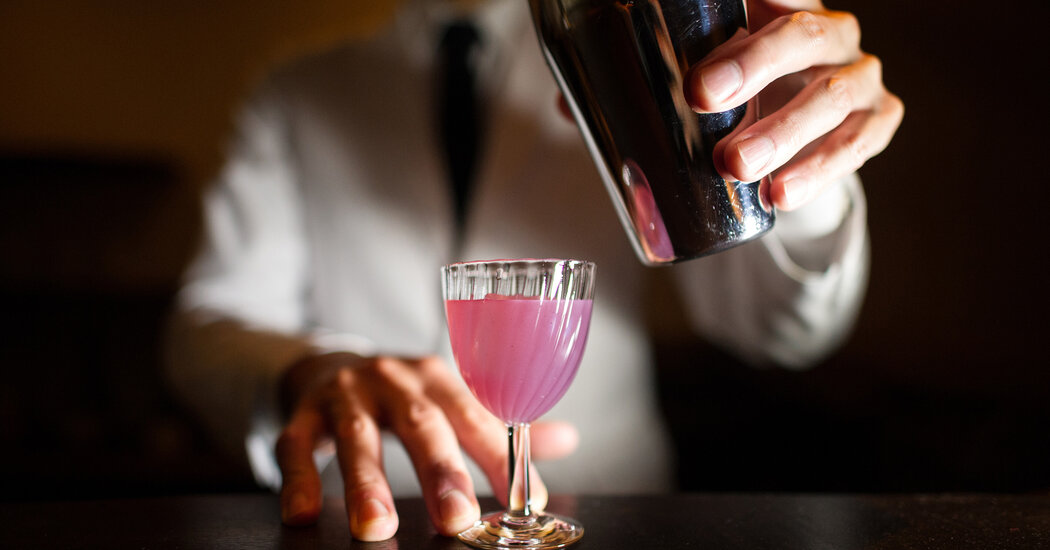Toward the end of the night at Theodora, an elegant Mediterranean restaurant that opened in Brooklyn’s Fort Greene neighborhood in February, diners at the polished concrete chef’s counter are often treated to the last thing they might expect in such a setting: a shot. It’s a ritual, explains Maggie Dahill, 27, Theodora’s beverage director, designed to encourage guests to feel part of a community. The shots, which the staff also partake in, change nightly and reflect the global inspirations of Theodora’s chef, Tomer Blechman, 46. Some are a perennial presence on the drinks menu, like a diminutive pour of Tubi, a citrus-based Israeli liqueur, or an ice-cold dose of vodka served with a skewered pickled mushroom in homage to the chef’s Latvian family. There’s a nonalcoholic option, as well. (On a recent night, it was a homemade fermented kumquat and rose soda.) “To some degree it’s less about the actual beverage and more about that moment of ‘cheers’ with somebody — that sense of connection,” Dahill says.
Theodora is one of a number of restaurants worldwide newly experimenting with miniaturized beverages. For some, the trend is inspired by the many cultures in which mid- and post-meal shots are a festive staple. For others — as is the case at Manhattan’s Tusk Bar, which opened in December and offers three different mini-martinis as oyster pairings (the option made with beet- and horseradish-infused vodka, for example, was designed to offset a hibiscus mignonette) — it marks a return to an earlier cocktail era. “Until World War II, cocktails were just two ounces of booze meant to be drunk very fast and very cold,” says David Wondrich, 63, the editor in chief of the definitive 2021 guide “The Oxford Companion to Spirits and Cocktails.” The 10-ounce martini that became popular after the war feels almost “unethical” to serve now, says Tusk’s bar director, Tristan Brunel, 35, who appreciates that the craft cocktail movement of the early 2000s shrank things back to three ounces of booze per drink. The Snaquiri, a two-ounce daiquiri shooter, popularized in New York in the mid-2010s by the influential Queens bar Dutch Kills, was smaller still, and the fun-size portion spread globally. In Tokyo, Gen Yamamoto, 45, has been serving an omakase of small-format cocktails for the past 11 years at his namesake bar. London’s Tayēr + Elementary introduced its 1.5-ounce One Sip Martini in 2019. And since opening in 2022, San Francisco’s For the Record has had a menu section devoted to cheekies — an industry term for beverages so small they shouldn’t even count. Now bartenders are shrinking their concoctions even further as they rethink what hospitality means after the pandemic.
At Adraba, a Levantine restaurant that opened last summer in Paris’s Montmartre district, complimentary shots are offered mid-meal as both a palate cleanser and a way of bringing people together. “Covid broke everything so much,” says Eden Bar, 32, a co-owner of the restaurant. “It alienated us from each other.” He hopes the shots make every meal feel like a joyous communal feast. The offerings, which change daily, are always heady with anise and often tempered with orange blossom, violet or basil syrup, which complement the richly spiced food.
When the restaurant director Jess Hereth, 42, and general manager Lauren Bruschi, 38, were devising the happy hour menu for Alpenrausch — an ode to all things Alpine that opened in Portland, Ore., last November — they wondered what the ritual meant in a much-changed industry. Unsure, Hereth and Bruschi, both self-described “lightweights,” created the menu they would want to find, one that gives diners a chance to try as many things as possible, while being realistic about budget and alcohol tolerance. In addition to what they call a “petite cocktail” — the My Little Mountain Guy, a 2¼-ounce apricot-inflected whiskey sour — the menu features a miniature schnaps flight: four half-ounce pours of the high-proof European-style liquors that range from fruity to bitter. They’re served in Lilliputian beer steins that look like they were pulled from a doll house. “We wanted to make appealing and approachable this niche thing we’re doing,” Bruschi says, aware of schnaps’s stigma among people who’ve only ever had the syrupy version, spelled with two “P”s. The name of the restaurant is Swiss German dialect for the rush you get when you’re hit with a gust of Alpine wind, and also slang for an alcohol buzz. The flight is Hereth and Bruschi’s way to make sure guests are blown away without being knocked out.







